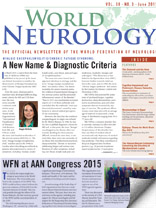By Raad Shakir

WFN/AAN leadership meeting 67th Annual AAN Congress, Washington, DC, 2015. From left to right, Gallo Diop, Ralph Sacco, Terence Cascino, William Carroll, Tim Pedley, Catherine Rydell, Raad Shakir, Riadh Gouider, Steve Lewis and Wolfgang Grisold.
The AAN is the largest single neurological association in the World Federation. The relationship goes back to the inception of the WFN. The WFN would not have existed without the generous assistance of $126,000 from the National Institutes of Health. This was only possible through the efforts of Dr. Pearce Bailey Jr., the first secretary general of the WFN and the second president of the AAN.
The AAN meeting this year was in Washington, DC, attended by 13,000 with a significant percentage of international delegates. There were 2,678 abstracts. The depth and breadth of the topics and the availability of teaching material is impressive.
Annual meetings of the leaderships of both organizations have become a tradition to discuss bilateral relations and international affairs. This year, there were several issues on the agenda, including joint support for African neurologists and full support for the burgeoning Pan American Federation of Neurological Societies bringing together Latin American neurologists. This organization is to encompass all neurological associations in Latin America and represents the Latin American region as one of six WFN regional organizations.
There was discussion on the creation of a Ted Munsat Award for Training and Education. The late Dr. Munsat was a past president of the AAN and chaired the WFN education committee for many years. There was agreement on creation of the fund, and this will be followed by more detailed discussions in the next few months.
The WFN last year created a regional liaison committee chaired by the AAN President Dr. Tim Pedley. This committee met and heard presentations from the six regions of the WFN. Closer collaboration between regions is the purpose of this committee and this is being achieved.
There is no doubt that neurological needs in Africa are paramount, and this was reflected in the leadership meetings and a special Pan African meeting, which was convened by the AAN and attended by stakeholders, including the leaderships of the two organizations and others including Dr. James Bower, Dr. Farah Mateen (chair, Global Health section) and Evelin Sipido representing the European Academy of Neurology with its special interest in annual courses for African neurologists.
Prof. Gallo Diop (Senegal) eloquently presented the needs and offered solutions with measures to ease the huge deficiency of neurologists in Africa. A tentative plan to train neurologists in Africa was discussed with the aim of opening four training centers, two in Francophone and two in Anglophone countries. Rabat and Cairo are already in operation, to be followed by Dakar and Cape Town.
The long-standing partnership between AAN and WFN continues from strength to strength. The AAN and the publisher donate the hard copies to the WFN, and the WFN distributes the course globally. It is now used in 47 countries. Dr. Steve Lewis is the editor and is a WFN co-opted trustee.
At the end of the meeting, Dr. Terence L. Cascino took over as president of the AAN, and Dr. Ralph L. Sacco was elected as president-elect.
No report on the 67th Annual Meeting of AAN could be complete without a special mention of the erudite lecture given by outgoing president Dr. Tim Pedley (link below). The title was “Moving the Academy Forward: Challenges and Opportunities,” and the talk was mesmerizing. His views on neurology as a nonprocedural specialty were spot on. Although the content understandably relates to the U.S. health care system, there are lessons for us all across the world. Indeed, our spectrum and capabilities have markedly improved but the challenges have also grown. The shortage of neurologists in the face of an aging population with increasing numbers of those affected by neurodegenerative diseases is frightening, and in a way it is now recognized by governments as the World Health Organization has emphasized in a recent meeting on dementia that this condition and its cost will cripple world economies in 30 years.
The close ties binding the WFN and the ANN will only grow stronger over the coming years.
https://www.youtube.com/watch?v=ya6mJ3rc2Gs&feature=youtube?
